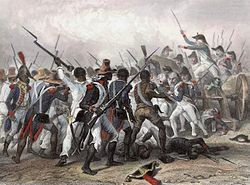| Part of a series on |
| North American slave revolts |
|---|
 Attack and capture of the Crête-à-Pierrot (Combat et prise de la Crête-à-Pierrot, March 1802) in the Haitian Revolution by Auguste Raffet, engraving by Ernest Hébert Attack and capture of the Crête-à-Pierrot (Combat et prise de la Crête-à-Pierrot, March 1802) in the Haitian Revolution by Auguste Raffet, engraving by Ernest Hébert |
| Context |
|
Before 1700
(Spanish Florida, victorious)
(Real Audiencia of Panama, New Spain, suppressed)
(Veracruz, New Spain, victorious)
(New Spain, suppressed)
(New Spain, suppressed)
|
|
18th century
(British Province of New York, suppressed)
(British Jamaica, victorious)
(British Chesapeake Colonies, suppressed)
(Louisiana, New France, suppressed) (Danish Saint John, suppressed)
(British Province of South Carolina, suppressed)
(British Province of New York, suppressed)
(British Jamaica, suppressed) (British Montserrat, suppressed)
(British Bahamas, suppressed)
(Louisiana, New Spain, suppressed) (Louisiana, New Spain, suppressed) (Dutch Curaçao, suppressed)
|
19th century
(Virginia, suppressed)
(St. Simons Island, Georgia, victorious)
(Virginia, suppressed) (Territory of Orleans, suppressed)
(Spanish Cuba, suppressed)
(Virginia, suppressed)
(British Barbados, suppressed)
(South Carolina, suppressed) (Cuba, suppressed) (Virginia, suppressed)
(British Jamaica, suppressed)
(off the Cuban coast, victorious)
(off the Southern U.S. coast, victorious) (Indian Territory, suppressed)
(Spanish Cuba, suppressed) (South Carolina, suppressed)
|
| Notable leaders |
The Samba rebellion was a purported slave rebellion, described by the French historian Antoine-Simon Le Page du Pratz in his Histoire de la Louisiane. The revolt is said to have taken place in 1731, in what was then French Louisiana. Contemporary with the Natchez revolt, it was personified to its alleged leader, an enslaved man called "Samba Bambara" (a member of the Bambara people from West Africa). While Le Page du Pratz gives a brief recollection of the events, which was more a conspiracy to revolt rather than an actual revolt, his information is not verified by any existent official documents.
The African-born Samba is reported to have participated in a number of revolts after being enslaved in Africa and during transit to Louisiana. He is also presented by Le Page du Pratz as having served the French as an interpreter and a slave overseer. The insurrection was due to take place in June 1731, but is said to have been revealed to the colonial authorities after an argument between an enslaved woman and a drunken French marine. Le Page du Pratz claimed to have participated in arresting the conspirators. While Samba refused to reveal any information even under torture, eight other slaves did confess to the conspiracy. The accused were publicly executed on the Place d'Armes, Jackson Square in New Orleans, on the orders of Gov. Étienne Perier. The sole woman involved was hanged, while the men were killed by use of a breaking wheel.
In 1936, the National Association for the Advancement of Colored People's magazine The Crisis published an article claiming that the Samba planned to kill all the whites and to keep enslaved non-Bambara Africans. Later scholarship has questioned the details about the revolt, including whether Samba had participated in prior uprisings and if the Bambara were as homogenous of a group as the contemporary reports implied.
See also
References
- Wood, Peter H. (2003). Strange New Land: Africans in Colonial America. Oxford: Oxford University Press. p. 96. ISBN 019-515-823-7.
- ^ Rodriguez, Junius P., ed. (2007). Encyclopedia of Slave Resistance and Rebellion. Santa Barbara: Greenwood Publishing Group. pp. 442–443. ISBN 978-031-333-273-9.
- Kelley, Robin D. G.; Lewis, Earl, eds. (2000). To Make Our World Anew: A History of African Americans. Oxford: Oxford University Press. p. 616. ISBN 019-513-945-3.
- Finkelman, Paul, ed. (2006). Encyclopedia of African American History, 1619–1895: From the Colonial Period to the Age of Frederick Douglass. Oxford: Oxford University Press. p. 397. ISBN 019-516-777-5.
- Rappeport, Stanley (September 1936). "Slaves Struggles for Freedom". The Crisis. New York City.
- Caron, Peter (1997). "'Of a nation which the others do not understand': Bambara slaves and African ethnicity in colonial Louisiana, 1718–60". Slavery & Abolition. 18 (1): 98–121. doi:10.1080/01440399708575205. ISSN 0144-039X.